Welcome back to the Cold War – pull up an ammo crate, we’re just getting started. For the last few months Sockbert and Daveydweeb have been slowly piecing together their first armies, learning to play a complex game that doesn’t naturally gel with their Mensa-like mastery of Warhammer 40,000 or Conquest. There’s a lot to learn, and only a fool would split their time, money and energy to start competing in tournaments in yet another wargame so soon after picking it up. It’d be like trying to swim with your feet tied to a concrete block, or possibly one of the metal-and-resin Shilkas in the Soviet range. Nobody would be so dumb.
Naturally, these two idiots then flew 500 miles to attend the WWIII: Team Yankee Oceanic Championships.
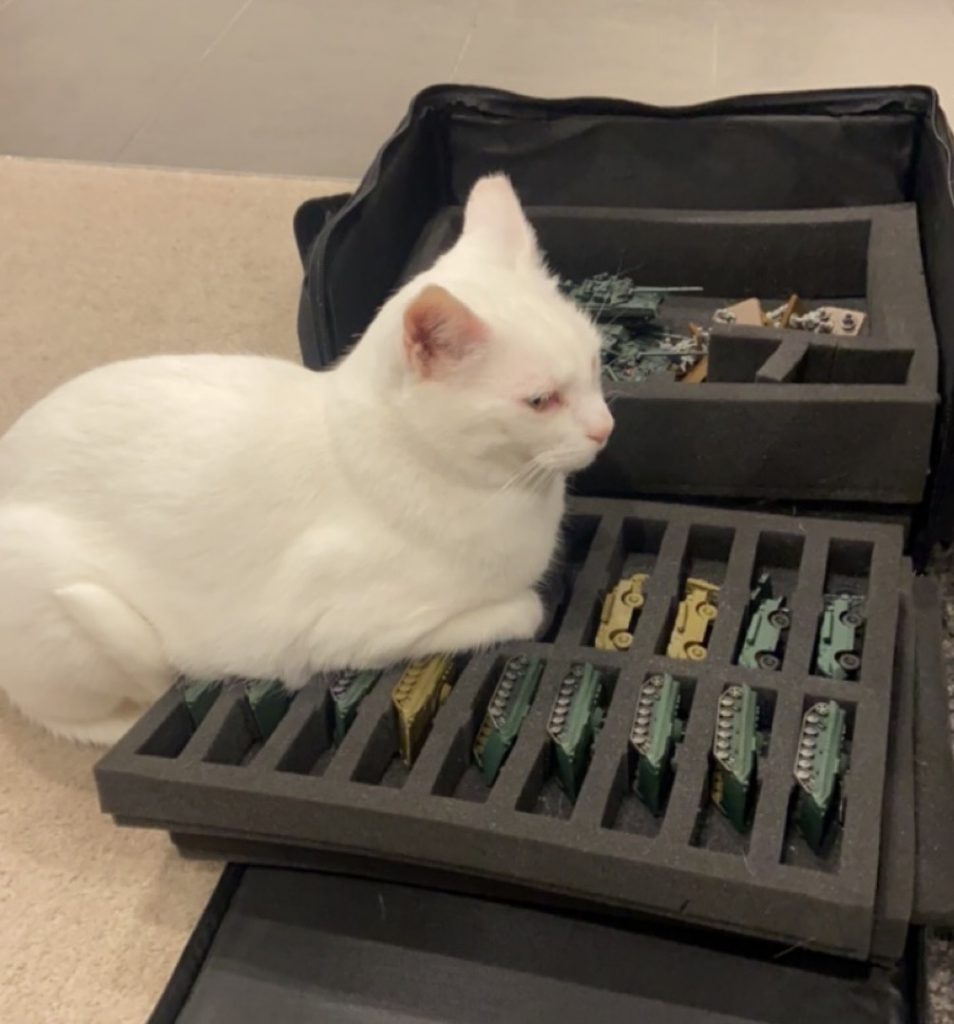
To keep the story rolling, we’ll be jumping between Davey and Sockbert’s experiences at this weekend-long event. Don’t worry, you won’t miss a thing. They both did terribly.
Wargaming, Australian Army-style
The WWIII Team Yankee Oceanic Championships was held in Melbourne, Australia on 18 – 19 November at the active Simpson Barracks Australian Army base, home of the Army School of Signals. The event was run by members of the Simpson Barracks Gaming Group, one of many that have blossomed in the Defence Force in recent years. Apart from being a relatively large event for WWIII: Team Yankee with 32-sign ups, the Oceanic Championships promised also to be the classiest wargaming tournament we’ve attended. Being hosted on an Army base, participants were required to wear collared shirts with strict standards for hygiene and behaviour. Newbies were warmly welcomed, loan armies were available on request, single-day play was a valid option, and there was a museum on site if you wanted some real world inspiration. Oh, and the hosts put on a genuine Aussie barbie, snags and all. As far as large tournaments go, this was Quite Chill.
Army list design rules were simple, including a few tweaks to minimise the spam and balance issues some other events have seen:
- 115 point lists, using only official rules and models.
- Maximum of 40 infantry stands (sorry, Iran).
- Maximum of 30 vehicles per chassis type (sorry, Sockbert’s bucket o’ Humvees).
With no restrictions on formation selections, this gave people plenty of scope to design lists with multiple core vehicle types, or potentially even using formations from allied nations. Seeing this potential for unbridled creativity, Sockbert and Davey did absolutely nothing about it and kept to their comfort zones like True Aussie Heroes.

Army Building and the Duality of Man
For this event, Sockbert’s destiny lay manifestly with the forces of the United States, and when the sounds of pops and whirring and bubbles from their sinister laboratory finally subsided, they emerged with a list that you could describe as “every LAV, everywhere, all at once”. Eventually they were talked down from the ledge of having army-wide maximum Front Armour 1, and reluctantly added a single unit of Abrams tanks and some infantry. Despite this change, this is still an army that aims to hurl enough 25mm shells downrange to blot out the sun.
Sockbert's brave and noble Yanks
Sockbert’s army was designed around finding some of the best vehicles in the American arsenal, pound-for-pound, and using a balance of art and science to spam the hell out of them. There’s plenty to fear in this force. The core is a massive horde of LAV-25s and LAV-ADs which pump out an enormous weight of AT8 fire over medium distances, and in test play they proved capable of nuking entire units of other infantry fighting vehicles. The concessional unit of M1A1 Abrams tanks is tough as hell and fires twice on the move, being an almost perfectly sized unit to jump out of Reserves. The TOWs, mounted on Humvees and Bradleys, should be able to kill anything that isn’t wise enough to hide from them, and we all know how resilient infantry can be when dug in. This force can pack a punch, but it’s still quite matchup reliant; BMPs fall in droves to it, but a single super-heavy tank on the other side of the field could prove catastrophic to Sockbert’s plans.
This is called foreshadowing.
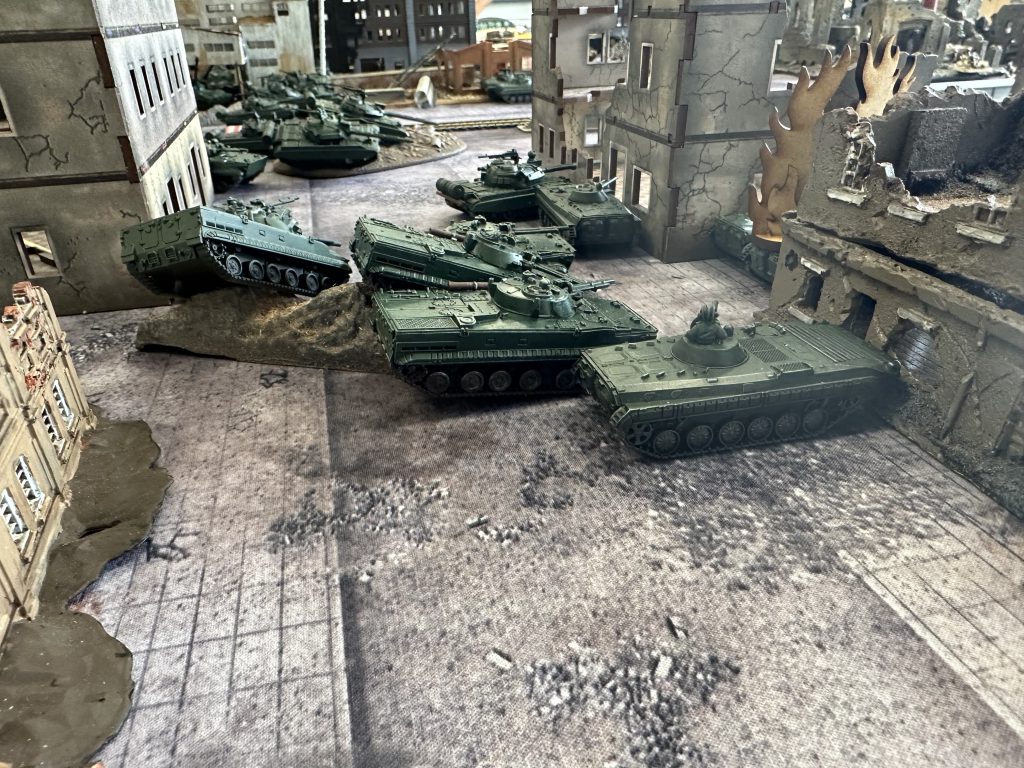
Daveydweeb, as per usual, took a more haphazard approach to planning. Given commitment issues, he was only able to confirm attendance at the event quite late and gave it not a thought until Sockbert insisted that he might want to start looking at flights, y’know, before the event. Suddenly faced with building and painting most of an army in only one week, he applied his usual coping technique of doing absolutely nothing about this problem until the night before, at which point he gave up and just used whatever crap he had lying around already. As moral support, Sockbert would regularly send kind, encouraging messages about how their army has been fully painted since September.
Daveydweeb's rolling horde of buff Communists
This is an attempt at a spammy but balanced Soviet list. On the one hand, you have the hammer: a large, mobile swarm of BMP-1s, -2s and -3s. Between them, they can aggressively deposit a large volume of anti-tank and autocannon fire into enemy flanks, most of which can be fired on the move. The anvil is a small core of high-quality T-80 tanks and a larger contingent of, uh, less-high-quality T-55AMs, supported by a medium-sized infantry brick that can dig in and survive artillery barrages all day long. The list sacrifices air power for competent anti-air coverage, and enough artillery to lay smoke or repeat bombardments on tricky infantry as required. If anything, the key weakness of this list is that it brings so many vehicles to the table that it efficiently transforms sweeping battlefields into car parks. Oh, and the dude playing it. That was a weakness too.
They both brought similar combined arms lists and had a similar plan for this event – have a pleasant time, try to win a game, and eat a lot of barbecued food.
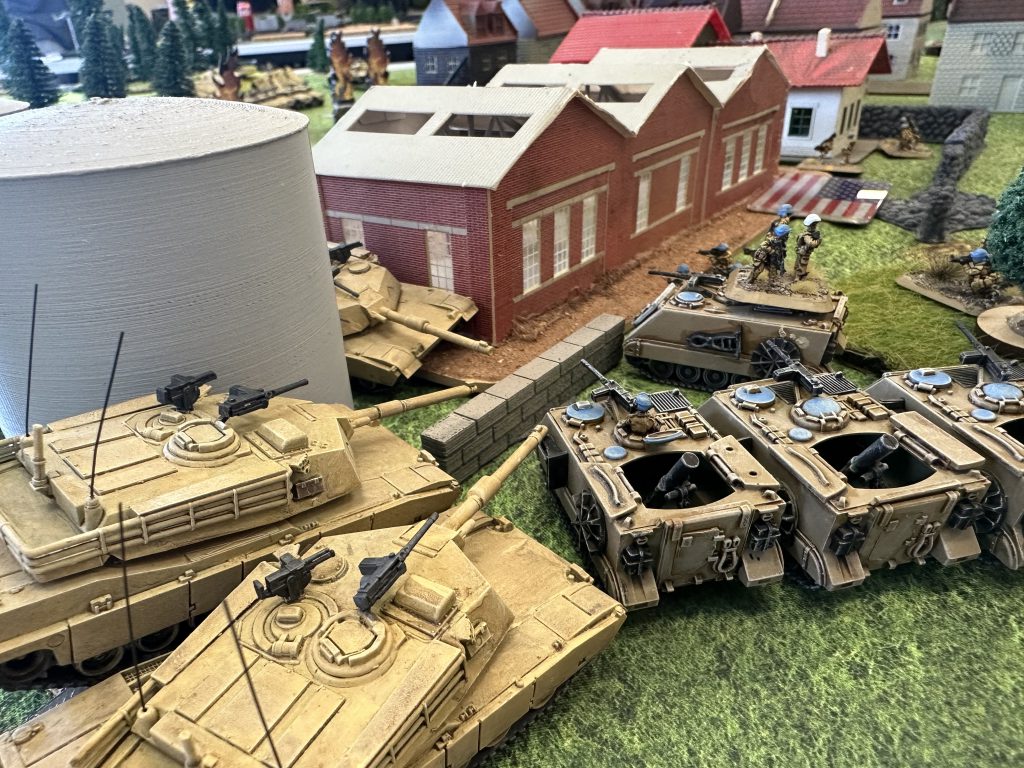
Intermission: A quick note about winning in the Cold War
Team Yankee tournament play has a wildly different feel from other game systems like Warhammer 40,000. Before we get into their experiences at Oceanics, it’s worth explaining a little about a typical Team Yankee game and how it tends to play, and how the games’ competitive mission pack differs from what you might already know and love.
Objectives don’t give you points or a score in Team Yankee – every objective is either a hard win or loss, or sometimes has a condition that allows the game to continue. Missions either have objectives for each player to capture, or have a single set for the players to fight over. This can lead to wildly asymmetric missions where one player attempts to cross the field to take two objectives protected by the enemy, while said enemy’s briefing is just “don’t die and also sorry, half of your force hasn’t show up yet”.. Objectives are player placed, and, due to the significantly more narrative terrain layouts than tournament-minded games like 40K, rolling up a mission on a particular board can feel like you’re going to steamroll all the way to Berlin, or may leave you feeling like you’re charging the guns at the Somme.
The other major thing to know about Team Yankee is that in any given scenario you are more likely to lose than you are to win. To illustrate this, let’s look at the closest thing the game has to a ‘default’ mission: Free For All.

Setting up a Free For All mission has both players placing objectives in their opponent’s deployment zone. The victory condition is simple: if you end a turn holding one of your objectives unopposed with a unit that started the turn there, you win. You need to completely remove the enemy from an objective, with exceptions like ‘Bailed Out’ tanks – although ‘Pinned Down’ infantry still contest them. Rarely, you can also win by completely eliminating the enemy force. Playing on a lazy Sunday afternoon, a mission like this could take a few hours to draw to an end – probably after a lot of death, destruction and Mountain Dew Baja Blast. But in a tournament, things change.
Scheduled play frequently forces a third outcome: when the clock runs out, no player wins and therefore both players lose. After a turn or two of brutal combat, it’s not uncommon that both players lack the combat power to take objectives. As a result, a mutual loss is the default: losing is normal, winning is a bonus. During this event, a player’s chance of winning any given game was only about 30%. You’ll note that a number of our games played ended in mutual losses – this is why.
Just a straight win/loss system would make ranking a tournament pretty hard, so Team Yankee also uses Victory Points as tie breaker; the fewer units the Winner lost, the better their score. In practice this means that most games will end up 6-3, which occurs the moment the Winner has lost three units. Since that’s so easy to achieve, you’ll often end up in situations where one player accepts their imminent defeat, works hard to get three kills, then concedes the game because the score can’t change any further.
So how did our heroes get on at the WWIII: Team Yankee Oceanic Championships?

Game one – Nick’s Trans-Atlantic Teamup vs Sockbert
Mission: Outflanked
Attacker: Nick Ashby
Result: Nick’s victory, both by VPs and by count of “I’m so sorry” before removing another of Sockbert’s units
Let’s get one thing straight: Sockbert is a kind, generous sort, the type of person who has a long, long track record of getting absolutely bodied in the first round of tournaments by the person who’d end up winning them. This tradition continued, with Nick’s Yanks and Poms teaming up to teach Sockbert a valuable lesson in what can happen when a great player builds a great list with the best components the game has available. British infantry are scarily good, particularly compared to the at-best-average American Army, and eight FV432 mortars for four points is, let’s be honest, a little obnoxious, especially compared to the three American M106’s Sockbert had for only a single point less.
Sockbert decided to bravely cower in the city while letting the roaming bandits own the countryside. This could have paid off, using the city to boost resilience while punishing anything that tried to cross the no man’s land of fields on the outskirts, but also relied on their ability to roll above a 4 when shooting NATO units concealed or gone to ground. Lacking this, Sockbert decided by turn two that the inevitable was, uh, inevitable, and started hunting rival HMMWVs to try and grab those three precious, precious VPs before Nick won the game. The survivability of infantry to ranged fire combined with the lethality of British marines in a city fight meant that once Nick did manage to take the town centre, there wasn’t much left that Sockbert could do. Goonhammer-branded M1A1s refused to arrive until Nick had established a gunline of TOW-2s and, combined with Nick’s ability to pick and choose the exact place and moment to apply pressure, meant that this wasn’t so much a matched battle as it was a clinical demonstration of what a highly skilled opponent can do with all the best tools at their disposal. Nick was a true gent, and it’s no wonder he ended up winning the whole event!
Thus began Sockbert’s journey at the Championships, an experience that they would later describe as “a series of unfortunate learning opportunities”.
Meanwhile, Davey sat down quietly to watch Michael Wright’s horde of Pattons yeet themselves up the field in a punishing assault on the central objective, in the mission Free For All. The heavy losses on both sides led to a mutual loss.
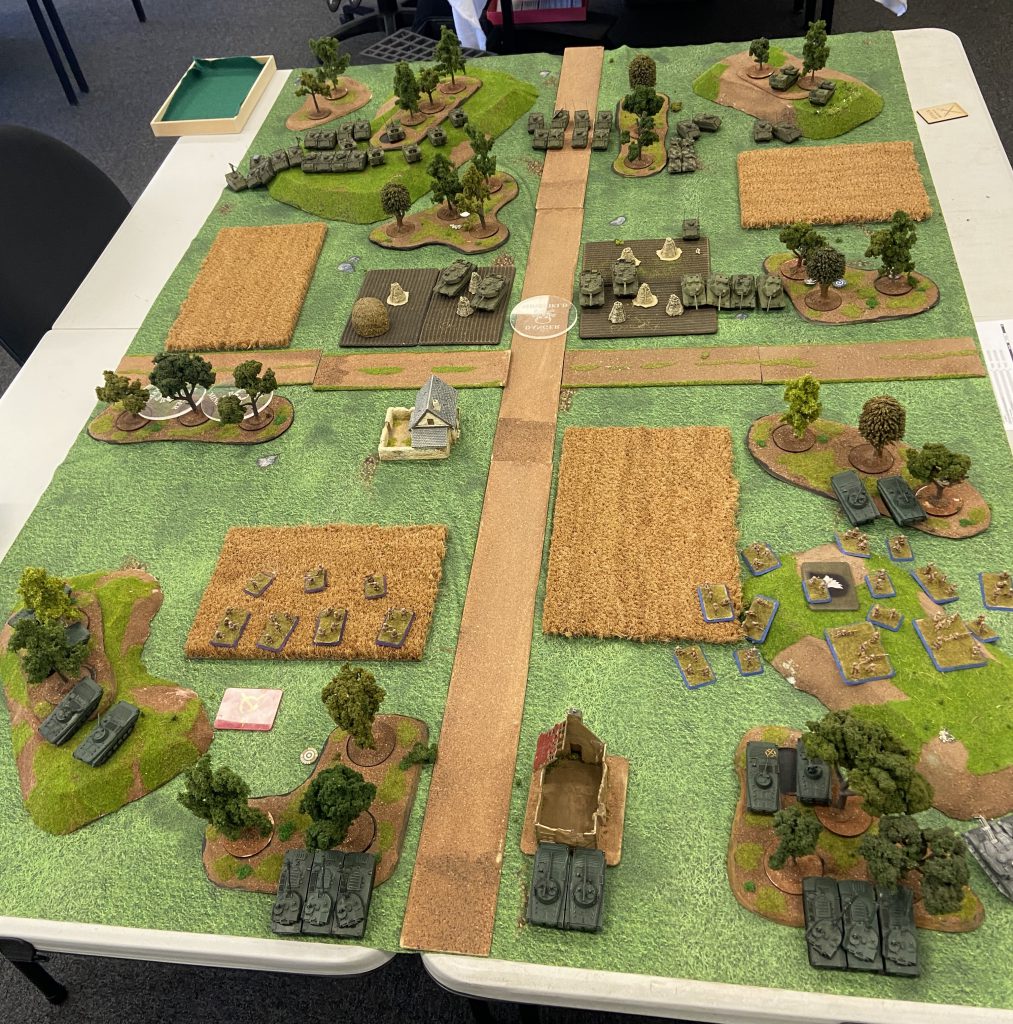
Game Two – Sully’s ANZACs vs Daveydweeb
Mission: Dogfight
Attacker: Sully
Result: Sully’s victory, with Davey losing before his third turn had begun
Round two paired Davey against Sully, who brought the Australian Army. Like, the whole thing. Every tank the Australians ever had. He’d taken full advantage of the newly-available M1A1 Abrams in the Australian Army, with large bricks of Leopard AS1s and M113s to bulk out the numbers. In any mission, this design is formidable: it’s fast, with massive damage output and impressive survivability. He was also Davey’s pick for best sportsman.That was important.
Dogfight is one of the Extended Battle Plans imported from Flames of War’s D-Day series, which event TOs have the choice of including. It’ll only appear when one player opts to Defend, a playstyle that it intended for infantry-heavy lists (which weren’t really viable in this tournament, given the spam restrictions). The mission has the defender lay down minefields and pray while they experience the most crushing version of the reserves rule Team Yankee has: Deep, Scattered, and Delayed. These reserves clearly do not have their ducks in a row. Not even one duck is in the right place, or even facing the right way. Honestly, these are terrible ducks.
Deep Reserves limits the defender to initially deploying only a single unit with a Front Armour of 4 or more. This matches the Late War version of Dogfight in the World War 2 setting of Flames of War, but this is the Cold War – even lightly-armoured BMP-3s have FA5. Consequently, Davey was forced to deploy with well under half of his force on the table – just 50 points to Sully’s 115. That’s unfortunate, but it gets worse: Delayed Reserves meant that on turn three, only a single unit could have arrived from reserves and only on a D6 roll of 5+. Reserves aren’t guaranteed until turn five, and the Attacker can win on any turn (after the first) by holding an objective. Even if the Defender could somehow hold on for that long, Scattered Reserves punishes them even further by bringing them on at a random point on your board edge. This is the stuff of nightmares for a Defender who hasn’t brought a huge brick of infantry to hold the points.
Sully played with maximum aggression, and Davey’s defeat was immediate, crushing, and, like, just a tiny bit hilarious for Sockbert. Davey’s objective defenders were decimated under immediate artillery fire, while his BMP-3s and BMP-1s were deleted by the end of the second turn with only a single kill to their name. With his M1A1s dashing up the board early, Sully was able to place them on an objective by the end of his second turn and, with the T-80s still off the board and reading their maps upside-down, the end was in sight. The game ended before the first reinforcement roll.
We need to pause for a moment and reflect on this mission design. Sully was a fantastic opponent and played the mission superbly, so no part of this editorialising reflects on him. FA4 is vastly too low a threshold for a unit to be considered a “battle tank” in this mission, and this penalty is both massive on turn one and only reduces randomly, up to five turns into the mission. Any part of Deep, Delayed, or Scattered reserves is a serious constraint, and combining all three becomes a gotcha, and a serious negative play experience. In theory, you can mitigate this by building an army that conforms to the requirements of a scenario you’re unlikely to play, but that army is far more likely to suffer in the other 80% of missions that don’t have Deep Reserves.
Looking at this from a newbie’s perspective, the 62-page mission pack is far too much to expect a rookie to have read and fully understood. We’ll write more about this in the future, but we do want to make the point that ‘losing to the mission’ really, really sucks. We strongly recommend ditching any scenario that has this kind of Reserves punishment, and instead adopt the Team Yankee NSW approach: 20% of your Reserves come on Turn One, the other 20% Turn Two. Conversation over. Daveydweeb is comfortable admitting that picking Defend without a seriously sturdy infantry-based force was very foolish, but at the same time, this scenario pack is far too demanding of brand-new players.
Sully was a wonderful opponent, who went on to place a well-deserved fourth overall. This game was perfunctory and by-the-numbers, completed in forty minutes, but redeemed by Sully’s wonderful company.
Meanwhile, Sockbert was grinning maniacally at hull-down Leopard 2A5s, without a gun left in their army that could do them harm. Do you hear that, Neo? That is the sound of… inevitability.
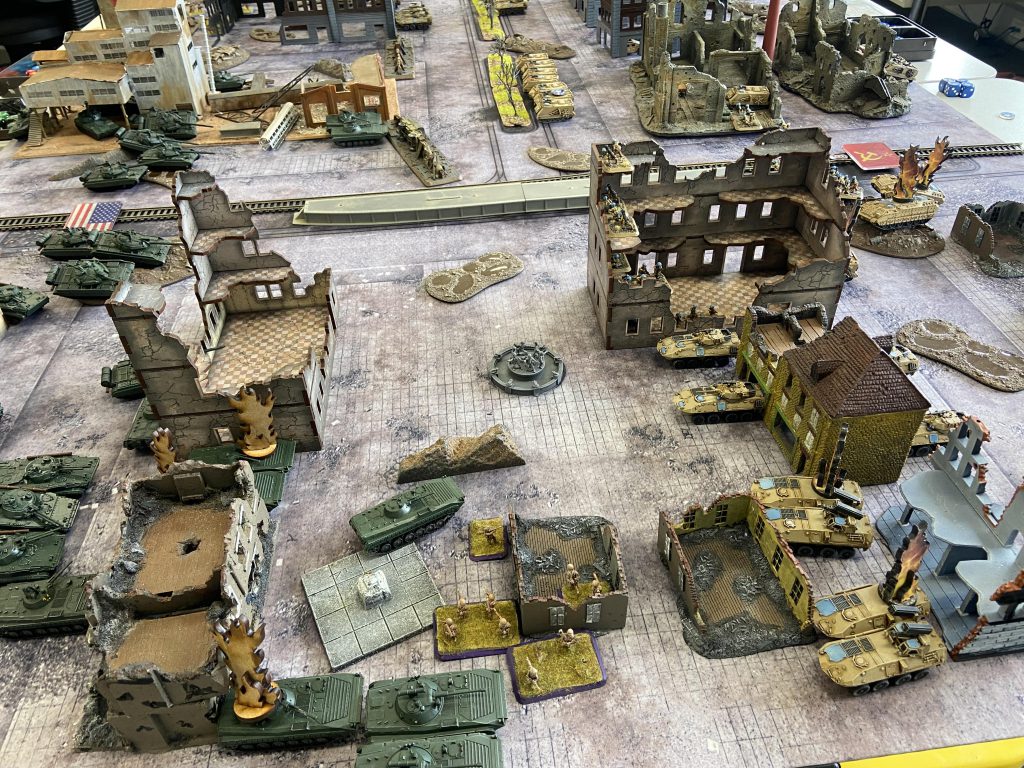
Game three – Daveydweeb vs Sockbert GRUDGEMATCH
Mission: Encounter
Attacker: Sockbert
Result: Daveydweeb tactical victory, Sockbert actual victory, Goonhammer publicity victory
Day two opened with a clash of titans – a Goonhammer grudge match, with Davey and Sockbert facing off across the ruins of a shattered city that the event organiser Andy was rightfully proud of. Encounter is a mirrored mission, requiring both players to capture objectives in the enemy deployment zones, and both players’ forces were full to the brim with vehicles that could kill essentially everything on the opposing side, and indeed had over and over in their lounge room games. This was going to be brutal.
Sockbert’s optimism continued, predicting confidently that a half-strength LAV company and some Bradleys count murder a mere Soviet infantry company, T-55 platoon and Carnation battery on their right flank. On their left flank, Davey was forced into a series of fascinating deployment choices due to the density of terrain, committing his armour to a slow push up the board, hoping eventually to place his T-80s onto that objective where they would be well-protected from return fire. Sockbert’s right flank confidence was crushed as their LAV’s murdered communist after communist, somehow revealing yet more Russian bodies after every volley. So, that was a wash then. Davey had more success down the other end of the board, trading many, many burning wrecks for a steady advance up the board.
The moment of the game came when Davey attempted to assault a building of Sockbert’s Army infantry, having earlier pinned them down in the shooting phase. This was wildly unsuccessful, with two T-80s and two BMP-3s destroyed and the charges failing to even reach the building, leaving Sockbert able to stall out the game long enough for those blessed M1A1 Abrams to arrive and just sort of… remove a lot of what Davey had left. Victory fell to Sockbert two turns later, when Davey helpfully pointed out that his own aggression had left the remaining victory point entirely undefended and out of range of his own units, but close to some of Sockbert’s Humvees that had been chasing down Russian artillery – Davey had been counting on a decisive victory that just never came.
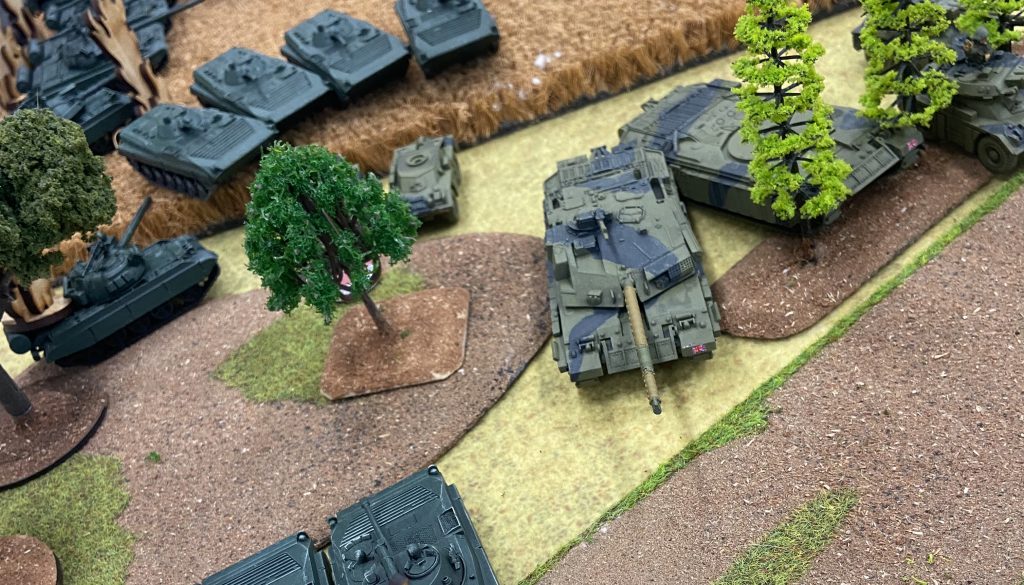
Game four – Daveydweeb vs Sam’s British Army Deathball
Mission: Valley of Death
Attacker: Sam
Result: [Benny Hill theme intensifies]
Sam’s an experienced Flames of War player, but Sunday was his first time playing Team Yankee. Finding themselves safely in the “ah hell, let’s just have fun” zone on the rankings, Davey and Sam committed to a light, fun, and hopefully quick game. Sam’s list was awesome, built basically to the “one starter box” archetype: seven Challengers, a couple each of Chieftains, Warriors and Harriers, and a couple of Foxes as a sort of exclamation mark.
Valley of Death can be brutal for an attack who doesn’t design his assault well, and Sam wasn’t going to fall into any traps. Using his Challengers like street sweepers, he barely missed a step as he systematically brushed away Davey’s chaff like… well, chaff. You know, that annoying grass stuff that gets stuck in your socks and itches a little. Broadly speaking, this is an accurate metaphor for Sam’s interactions with Davey’s army.
The game developed into a bit of a stalemate, in which Sam’s shortage of Harriers and lack of artillery meant he could never quite dislodge Davey’s infantry from the two objectives. Meanwhile, Davey’s BMP-3s went on a massive 90+ inch tour of the battlefield trying to get flanking shots on the Challengers, finally whittling them down to two – including, critically, the commander who would give rerolls to his surviving brother. The game ran on and on, with Sam unable to clear the infantry with only a couple of surviving tanks, and Davey unable to repel the attack after bailing out the Challengers for like the sixth or seventh time because of those crucial remount rerolls. Finally, well past the limits of the provided D12-shaped turn counter, the game clocked out with a draw, with Sockbert getting increasingly panicky about imminent flight times in the background. By now they’d drawn a crowd of jovial onlookers who, upon arriving at the table, would predictably ask “what turn are we up to?” followed by “are you serious?”
Meanwhile, Sockbert had travelled 500 miles to play the gentleman who ran most of Team Yankee NSW’s local events, and had the informative experience of what happens when the guy who ends up winning Best Warsaw Pact decides to use those skills on twenty two aircraft.
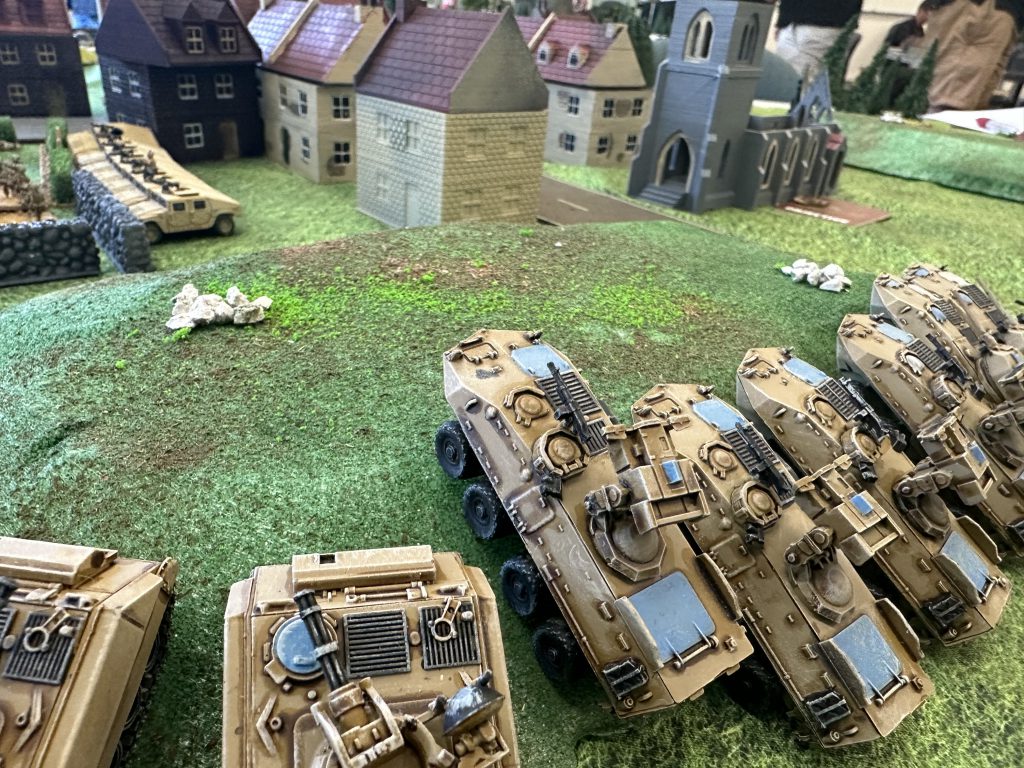
A post-battle sausage sizzle
Team Yankee events are great – this isn’t our first, and it won’t be our last, but this has been the first time either of us had travelled for more than about four hours, and it was absolutely worth it. Team Yankee is the type of game you can play in your living room with a mate, taking six hours for a normal game and loving every relaxed minute, but it plays very differently under the pressure of a proper tournament. Every player here was lovely to our ignorant souls, and we wanted to give a shout out to the wonderfully welcoming group of wargamers who joined us for the weekend. It was the people who made this a fantastic event, from Andy and the event team down to every one of the participants. You can have a great game with great models in a great setting but without the people, it all falls over.
The Team Yankee Oceanic Championships was amazing. Come play with us.
Questions, comments, suggestions? contact@goonhammer.com or leave a comment below


